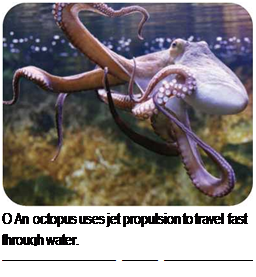Jet and Jet Power
The concept of jet power has been around for thousands of years. In the first century c. e., Hero (also known as Heron) of Alexandria, Egypt, invented a jet-powered device called the aeolipile. It was a hollow metal ball supported on a frame. Steam inside the ball escaped through two bent pipes. The jets of steam rushing out of the pipes made the ball spin.
Today’s jet engines produce power by a similar, simple process of heating gas. Fuel burned inside an engine combines with oxygen from the air to produce hot gas. As the gas heats up, it expands so much and so fast that it blasts out of the engine as a high-speed jet.
Jet engines were originally developed to produce faster fighter planes. Since then, the use of jet power has spread to airliners and helicopters and further afield-to ships, record-breaking cars, and other uses.
What Is Jet Power?
Jet power is a kind of power that follows Isaac Newton’s third law of motion, which says: “To every action, there is an equal and opposite reaction.” The action and reaction are equal and opposite forces. The jet of gas rushing out of a jet engine pushes against the engine, and the engine pushes back against the gas. They push each other in opposite directions.
The easiest way to see this in action is to blow up a balloon and then let it

 The animal world used jet power long before humans discovered it. Squid, octopus, and cuttlefish are among marine creatures that use jet propulsion. They suck in water and then blow it out in a fast jet to propel themselves through the water. Squid have been recorded jetting through the water at up to 25 miles per hour (40 kilometers per hour). The scallop shellfish uses jet propulsion to escape from danger. It quickly snaps the two halves of its shell together, squirting out water in the process. The squirt produces a jet, enabling the scallop to scoot out of harm’s way.
The animal world used jet power long before humans discovered it. Squid, octopus, and cuttlefish are among marine creatures that use jet propulsion. They suck in water and then blow it out in a fast jet to propel themselves through the water. Squid have been recorded jetting through the water at up to 25 miles per hour (40 kilometers per hour). The scallop shellfish uses jet propulsion to escape from danger. It quickly snaps the two halves of its shell together, squirting out water in the process. The squirt produces a jet, enabling the scallop to scoot out of harm’s way.
 Turbine Engines
Turbine Engines
Jet thrust is only one way of using jet power. The turbofans that power jet planes use a jet of gas from the engine to spin a large fan at the front of each engine. Turboprop engines use a jet to spin a propeller. The engines that power most helicopters today use the jet of gas from their engines to turn the aircraft’s rotors. All of these engines are known as gas turbines, or turbine engines.
In the 1930s and 1940s, turbine engines for aircraft were developed by two men working separately: Frank Whittle in England and Hans von Ohain in Germany. The introduction of jet power produced a sudden leap in aircraft speeds. The first jet fighters built in the 1940s were 100 to 200 miles per hour (160-320 kilometers per hour) faster than piston-engine fighters of the period. They triggered a race among nations to develop faster and faster military jet planes.
О A large jet engine is opened up for maintenance.










